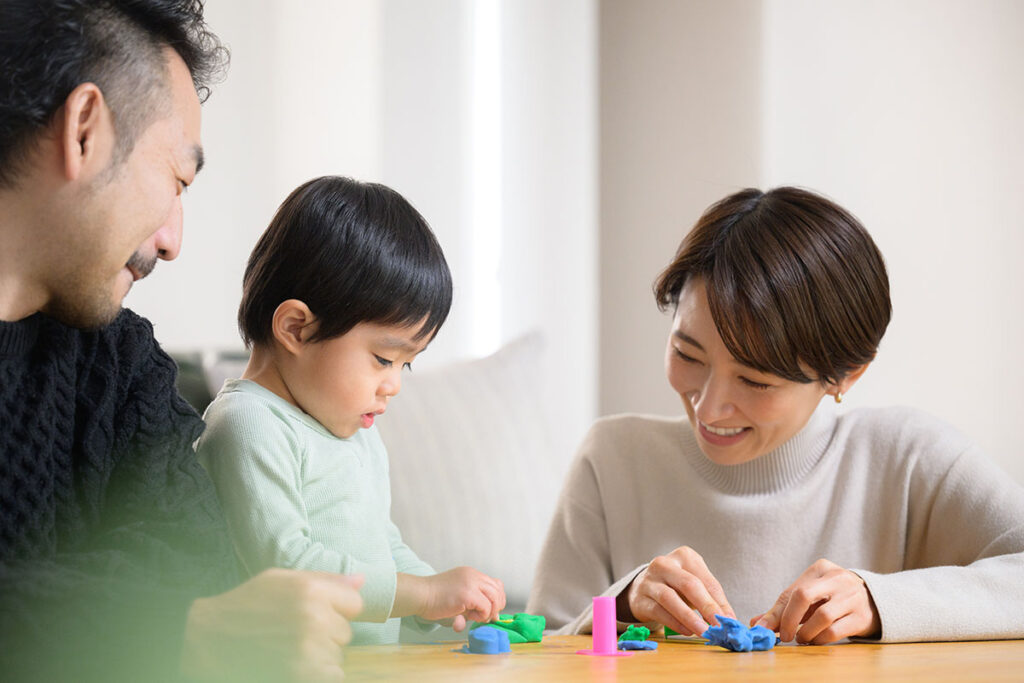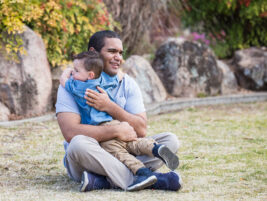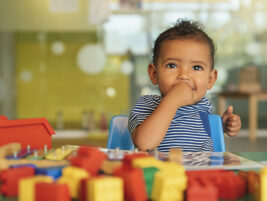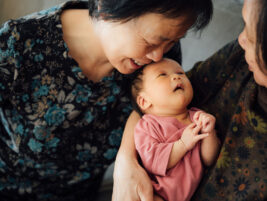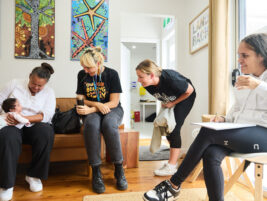In the first years of life, the risk for exposure to severe stressors and potentially traumatizing events is heightened, with a risk for profound short- and long-term consequences on health and development. Yet services for the youngest population are often scarce, underdeveloped and not research-based. This article describes the dissemination process of Child-Parent Psychotherapy in Sweden and Norway through a clinical and academic training collaborative, research, and the formation of a Nordic network. Experiences, lessons learned, insights, and thoughts from the past ten years will be discussed.
Introduction
Infants and young children exposed to potentially traumatic events such as child abuse and neglect, intimate partner violence, medical trauma, war, natural disasters, or other adverse life events risk negative consequences on their immediate and long-term development and well-being (Grummitt et al., 2021; Hunt et al., 2017; Lippard & Nemeroff, 2020; Yu et al. 2022). Data from various cultural contexts indicate that a substantial proportion of children exposed to maltreatment and interpersonal trauma are under the age of 6 years (Jernbro & Jansson, 2017; US Department of Health & Human Services, 2022). Simultaneously, a solid body of research has established the youngest children’s particular vulnerability to adverse neurodevelopmental effects (Nelson & Gabard-Durnam, 2020; Teicher & Samson, 2016). Early exposure is associated with a high risk of significant adverse short- and long-term consequences on physical, mental, cognitive, and social health and development that often persist into adolescence and adulthood (Grummitt et al., 2021; Hunt et al., 2017; Lippard & Nemeroff, 2020; Woolgar et al., 2022; Yu et al., 2022). Many of these children demonstrate post-traumatic stress related to the exposure to trauma and adverse events and often need specific trauma-informed treatment (Hiller et al., 2016; Holt et al., 2008).
While infants and young children are at high risk of negative consequences of traumatic and adverse life events, they are also at an age where interventions can make a crucial difference in their health and development. Intervening early with relationship-based treatment models offers the potential to intervene in the parental caregiving system, with both short- and long-term benefits (Zeanah, 2019). In many countries, effective and evidence-based treatments specifically developed for children aged 0-6 exposed to trauma are scarce and insufficiently offered to young children and families. Many interventions are not effective enough for young children (Gutermann, 2016), and additionally, many interventions are not culturally appropriate and fail to consider the diverse cultural dynamics of the families served, resulting in limited effectiveness. As a result, many children and caregivers continue to struggle with remaining difficulties associated with relational challenges and post-traumatic stress. This is particularly true for the youngest children. (Furmark & Neander, 2018; Hooker et al., 2022; Osofsky & Lieberman, 2011; Vanderzee et al., 2016).
In summary, infants, toddlers, and preschoolers are at higher risk of exposure, risk severe consequences, and have less access to services than older children and adults, despite being at an age when interventions could be the most effective (Nelson, 2020; Sullivan, Roubinov et al., 2024; Zeanah, 2019).
Child-Parent Psychotherapy
Child-Parent Psychotherapy (CPP) is a diversity-informed treatment model developed specifically for children aged 0-6 and their caregivers affected by the consequences of trauma (Lieberman et al., 2015). The model emphasizes a strong commitment to diversity, equity, inclusion, and respect for family and cultural values, which are integral to the therapeutic process. CPP is relationship-based, integrating developmental, attachment, psychodynamic, cognitive-behavioral, social-learning, and trauma theories to provide comprehensive support. . The model aims to decrease the impact of trauma by strengthening the caregiver–child relationship, (re)establishing the child’s sense of safety, and restoring the child’s development to a typical trajectory (Lieberman et al., 2015). Modalities and interventions include play, attachment promotion, developmental guidance, translation of the child’s emotional expression in behavior and play to the caregiver to help them understand each other better, enhancement of dyadic and body-based affect regulation, emotional support, and processing past caregiver traumas.
Five randomized controlled trials have demonstrated the effectiveness of CPP, showing decreased child and parental psychiatric symptoms, improved child–parent relationships, and increased cognitive functioning (Cicchetti et al., 1999; Cicchetti et al., 2006; Lieberman et al., 1991; Lieberman et al., 2006; Toth et al., 2002). CPP is one of few evidence-based treatments specifically targeting children aged under six years suffering negative consequences of trauma and adverse life events (for an overview see Dozier & Bernard, 2023). In a recent study, CPP was found to be associated with lower epigenetic age acceleration, a biomarker associated with later adverse physical and psychiatric outcomes (Sullivan, Merrill et al., 2024).
The dissemination of Child-Parent Psychotherapy in Sweden and Norway
To improve services for young children, CPP was introduced in Sweden and Norway, where the model had not been previously practiced. Professor Kjerstin Almqvist initiated a feasibility study and training in Sweden in 2013 as part of a research program about treatment for children exposed to violence, funded by the Swedish National Board of Health and Welfare. A training program was developed in close collaboration and with the support of the developers at the Child Trauma Research Program, University of California, San Francisco (Alicia Lieberman & Chandra Ghosh Ippen).
Besides the training of clinicians and trainers, the implementation of CPP in Sweden and Norway has included research and the formation of a Nordic network for CPP to scaffold training, research and clinical practice.
Training
Two Swedish and three Norwegian trainers have been trained who now provide training in Swedish and Norwegian. Training is offered continuously, ten cohorts and approximately 190 clinicians, working in a variety of contexts have been trained, e.g. child and adolescent mental health services, (CAMHS), social services, units specialized in trauma or in infant mental health, children’s hospitals, non-governmental organizations (NGOs), and primary health care. The majority of participants have been clinical psychologists or social workers.
Nordic research
Simultaneously with training and implementation in practice, research has been realized (Almqvist et al., 2018; Norlén et al., 2021; Norlén et al., 2024; Pernebo et al., 2023). Ongoing research includes a follow-up of the effectiveness study and a study on the feasibility of CPP for children in foster care that includes both qualitative interviews with children, caregivers, and therapists, and quantitative data on outcomes e.g. symptoms in children and caregivers. Additionally, a study on the implementation of CPP in Norway is underway.
A feasibility study, conducted in conjunction with the first training, indicated that CPP was appropriate in the Swedish context without particular adjustments. The method was appreciated by clinicians and families, and the positive results from studies in the United States seemed to be similar in a Swedish context. The conclusion was that CPP is a method well suited for the target group in Sweden (traumatized children 0-6 years) without essential adaptations (Almqvist et al., 2018, Broberg et al., 2015). These findings contributed to the decision in 2016 by the Swedish National Board of Health and Welfare to support the dissemination and implementation of CPP in Sweden.
In another Swedish study, Norlén et al. (2021) investigated the experiences of caregivers who had taken part in CPP with their child. Results revealed that caregivers appreciated the intervention. Their reported experiences illustrate how CPP was perceived as improving parenting skills, contributing to the child’s development, for example, an enhanced capacity to recognize and regulate feelings and reactions, and improving parents’ understanding of and communication with their child.
In a one-group, pretest-posttest design the effectiveness of CPP in a Swedish naturalistic multi-site clinical setting was investigated (Norlén et al., 2024). Reductions in post-traumatic stress and general psychological symptoms with small to medium effect sizes were found in both children and caregivers. Caregivers also reported improvements in the caregiver-child relationship. The study supports that CPP addresses and reduces both symptoms of the individual child and the caregiver, and improves the child – caregiver relationship. Further, the results suggest that the dyadic model addresses the association between child traumatic stress and caregiving capacities; for example, reductions in the child’s PTSD symptoms were associated with a decrease in the caregiver’s report of disorganized parenting.
The findings from these three studies (Almqvist et al., 2018; Norlén et al., 2021; Norlén et al., 2024) support that CPP is a promising method for traumatized preschool children, and is possible to implement in various regular services in Sweden.
With the aim to explore the extent to which clinicians trained in CPP continued to work with the model after training and how they experienced its implementation and sustainability over time, a study with a mixed-methods design was conducted (Pernebo et al., 2023). In this study, a survey was distributed to all 66 clinicians in Sweden trained in CPP at the time, and interviews were conducted with a sample of 12 clinicians. The results showed that most clinicians continued to work with CPP after the training, they found the model enjoyable and rewarding, and they were confident that CPP was effective. Few young children, however, seemed to access treatment, and few clinicians had treated enough cases to acquire extended experience or expertise. The organization’s readiness to implement new methods, collegial support, and legal processes involving the child were factors that affected implementation and sustainability. In this study it was concluded that the implementation and sustainability of CPP seemed to be both facilitated and hindered by factors at a systems-level, within the organization, and by individual factors. Particularly worrying was the indication that few young children affected by trauma accessed evidence-based treatments, and that serving this population was often not a priority at a systems and organizational level.
A Nordic network
A Nordic network has been established to scaffold CPP training, research, implementation, and sustainability. The aim of the network is twofold. First, it offers an opportunity for trainers and key persons responsible for organizing training, conducting research, or are involved at systems level in CPP-related activities to meet and support each other in planning and conducting training, meetings, research, and work on a systems level. Second, the network offers an opportunity for all CPP-providers to be connected, share experiences and further learning, and support each other in sustaining fidelity in the model. The network has organized activities and meetings for participants from both Norway and Sweden, including on-site meetings for continuous learning through consultations and case-based learning, webinars, research updates, and reflective learning sessions focusing on specific themes such as working with offending fathers, working with children in foster care, and implementing CPP in social services.
Discussion and Conclusion
CPP has been found to be effective, applicable in a Nordic context, and is appreciated by clinicians and caregivers. The model seems to fill a gap in the services provided for the youngest children affected by trauma. Still, clinicians in the implementation study reported that services for these children were often not prioritized and that few young children accessed treatment (Pernebo 2023). Furthermore, several described a sense of how implementing and providing treatment for the target group ended up being their individual responsibility as clinicians and informal champions for services for young children, instead of being driven by leadership, policy, and national recommendations. This makes the implementation and sustainability of the model vulnerable to staff and leadership turnover, economical strains, and political changes, ultimately leading to scarce and unequal access to care. In Norway this is somewhat less evident due to a system with a national and regional organization, a competence center for child and adolescent mental health, responsible for dissemination, training, and sustainability of evidence-based practices in child and adolescent mental health. In Sweden, this structure is lacking on a national level. Despite a robust knowledge base on the potentially detrimental effects of experiencing trauma at an early age, and on how treatment can help, this knowledge is not translated into policy, sustainable systems and structures, and services that reach children and families.
On a more positive note, there are several findings that convey hope. The experiences of caregivers and providers, the demonstrated decrease in symptoms in children and caregivers, and the improvement in child-caregiver relationship indicate CPP to be effective. Providers describe CPP as a treatment model and therapeutic approach that gives them a sense of security, with procedures and fidelity measures as something to hold on to when facing complex cases, many times without much support. The CPP model is more than techniques and specific procedures. Its components include reflective practice, care coordination, focus on the therapeutic relationship, and psychoeducation integrated in the engagement and assessment phase. In this work addressing experiences related to historical trauma, racism, power and other injustices that may have been experienced is paramount to CPP work. This professional stance seems to be experienced by providers as concordant with what is needed when working with young children and families struggling with complex issues in the light of exposure to trauma and adversities.
Training in CPP also provides the clinician with a network of colleagues, instilling a sense of not being alone in this work. The Nordic providers have highlighted having colleagues to discuss and reflect with as essential and rewarding, promoting sustainability and fidelity in the model.
Sweden and Norway have been ranked as the best countries in the world for raising children (OECD, 2024) and among the top three for mental health, with scores based on several factors from OECD reports (William Russel, 2024). Our experiences from the dissemination and implementation of CPP, as well as the results from research however, show that there are still challenges and gaps in services when it comes to serving the youngest and most vulnerable citizens affected by trauma and in need of assessment, support and treatment.
References
Alisic, E., Zalta, A. K., van Wesel, F., Larsen, S. E., Hafstad, G. S., Hassanpour, K., & Smid, G. E. (2014). Rates of post-traumatic stress disorder in trauma-exposed children and adolescents: Meta-analysis. The British Journal of Psychiatry, 204, 335–340. https://doi.org/10.1192/bjp.bp.113.131227
Almqvist, K., Bäccman, C., Anderzen-Carlsson, A., Norlén, A., Pernebo, K. & Massoudi, P. (2018). iRiSk II: Utveckling av bedömningsinstrument och stödinsatser för våldsutsatta barn – rapport från två delprojekt [In Swedish. The development of assessment instruments and supportive interventions for children affected by violence. A report from two projects.]. Karlstads universitet. http://kau.diva-portal.org/smash/get/diva2:1206123/FULLTEXT01.pdf
Broberg, A., Almqvist, K., Appell, P., Axberg, U., Cater, Å., Draxler, H., … Röbäck de Souza, K. (2015). Utveckling av bedömningsinstrument och stödinsatser för våldsutsatta barn. [In Swedish. The development of assessment instruments and supportive interventions for children affected by violence]. Psykologiska institutionen, Göteborgs universitet.
Cicchetti, D., Rogosch, F. A., & Toth, S. L. (2006). Fostering secure attachment in infants in maltreating families through preventive interventions. Development and Psychopathology, 18, 623–649. https://doi.org/10.1017/S0954579406060329
Cicchetti, D., Toth, S. L., & Rogosch, F. A. (1999). The efficacy of toddler-parent psychotherapy to increase attachment security in offspring of depressed mothers. Attachment and Human Development, 1, 34–66. https://doi.org/10.1080/14616739900134021
Dozier, M., & Bernard, K. (2023). Intervening Early: Socioemotional Interventions Targeting the Parent-Infant Relationship. Annual Review of Developmental Psychology, 5(1), 115–135. https://doi.org/10.1146/annurev-devpsych-120621-043254
Furmark, C., & Neander, K. (2018). Späd- och småbarnsverksamheter/team i Sverige – en kartläggning (2018:2) [In Swedish. Infant mental health services in Sweden – an overview.]. Nationellt Kunskapscentrum Anhöriga. https://anhoriga.se/Global/BSA/Bilder/Sp%C3%A4d%20och%20sm%C3%A5barnsverksamhet/BSA-2018-2_Furmark_Neander_webb.pdf
Grummitt, L. R., Kreski, N. T., Kim, S. G., Platt, J., Keyes, K. M., & McLaughlin, K. A. (2021). Association of Childhood Adversity With Morbidity and Mortality in US Adults: A Systematic Review. JAMA pediatrics, 175(12), 1269–1278. https://doi.org/10.1001/jamapediatrics.2021.2320
Gutermann, J., Schreiber, F., Matulis, S., Schwartzkopff, L., Deppe, J., & Steil, R. (2016). Psychological Treatments for Symptoms of Posttraumatic Stress Disorder in Children, Adolescents, and Young Adults: A Meta-Analysis. Clinical Child and Family Psychology Review, 19(2), 77–93. https://doi.org/10.1007/s10567-016-0202-5
Hiller, R. M., Meiser-Stedman, R., Fearon, P., Lobo, S., McKinnon, A., Fraser, A., & Halligan, S. L. (2016). Research review: Changes in the prevalence and symptom severity of child post-traumatic stress disorder in the year following trauma – a meta-analytic study. Journal of Child Psychology and Psychiatry, 57, 884–898.
Holt, S., Buckley, H., & Whelan, S. (2008). The impact of exposure to domestic violence on children and young people: A review of the literature. Child Abuse and Neglect, 32, 797–810.
Hooker, L., Toone, E., Wendt, S., Humphreys, C., & Taft, A. (2022). RECOVER – Reconnecting mothers and children after family violence: The child–parent psychotherapy pilot (Research report, 05/2022). ANROWS.
Hunt, T. K. A., Slack, K. S., & Berger, L. M. (2017). Adverse childhood experiences and behavioral problems in middle childhood. Child abuse & Neglect, 67, 391–402. https://doi.org/10.1016/j.chiabu.2016.11.005
Jernbro, C., & Janson, S. (2017). Våld mot barn 2016. En nationell kartläggning. [In Swedish. Violence against children 2016. Report.] Stiftelsen Allmänna Barnhuset. https://wwwallmannabarnh.cdn.triggerfish.cloud/uploads/2017/08/V%C3%A5ld_mot_barn_2016_reviderad.pdf
Lieberman, A. F., Ghosh Ippen, C., & Van Horn, P. (2006). Child-parent psychotherapy: 6-month follow-up of a randomized controlled trial. Journal of the American Academy of Child & Adolescent Psychiatry, 45, 913–918. https://doi.org/10.1097/01.chi.0000222784.03735.92
Lieberman, A. F., Ghosh Ippen, C., & Van Horn, P. (2015). Don’t hit my mommy! A manual for child-parent psychotherapy with young children exposed to violence and other trauma (2nd ed.). Washington, DC: ZERO TO THREE.
Lieberman, Weston, & Pawl (1991). Preventive intervention and outcome with anxiously attached dyads. Child Development, 62, 199-209.
Lippard, E. T. C., & Nemeroff, C. B. (2020). The devastating clinical consequences of child abuse and neglect: Increased disease vulnerability and poor treatment response in mood disorders. American Journal of Psychiatry, 177, 20–36.
Nelson, C., & Gabard-Durnam, L. (2020). Early adversity and critical periods: Neurodevelopmental consequences of violating the expectable environment. Trends in Neurosciences (Regular Ed.), 43, 133–143.
Norlén, A., Bäccman, C., Thorén, A., & Almqvist, K. (2024). The Effectiveness of Child-Parent Psychotherapy on Traumatized Preschoolers and Their Caregivers: A Swedish Multi-Site Study. Evidence-Based Practice in Child and Adolescent Mental Health, 1–16. https://doi.org/10.1080/23794925.2024.2358486
Norlén, A., Thorén, A., & Almqvist, K. (2021). Implementing child-parent psychotherapy (CPP) in Sweden: A qualitative study exploring experiences by caregivers taking part of the intervention with their child. Journal of Infant, Child, and Adolescent Psychotherapy, 20, 152–168. https://doi.org/10.1080/15289168.2021.1925001
OECD, 2024, Family database. PF 3.1 Public spending on childcare and early education., https://www.oecd.org/content/dam/oecd/en/data/datasets/family-database/pf3_1_public_spending_on_childcare_and_early_education.pdf (accessed on Sept 21, 2024)
Osofsky, J. D., & Lieberman, A. F. (2011). A call for integrating a mental health perspective into systems of care for abused and neglected infants and young children. The American Psychologist, 66(, 120–128. https://doi.org/10.1037/a0021630
Pernebo, K., Alåsen, M., Axhed, A., & Massoudi, P. (2024). Facilitators and barriers to the implementation and sustainability of child-parent psychotherapy in Sweden: Clinicians’ experiences. Children and Youth Services Review, 159, 1–9. https://doi.org/10.1016/j.childyouth.2024.107526
Sullivan, A. D. W., Merrill, S. M., Konwar, C., Coccia, M., Rivera, L., MacIsaac, J. L., Lieberman, A. F., Kobor, M. S., & Bush, N. R. (2024). Intervening After Trauma: Child–Parent Psychotherapy Treatment Is Associated With Lower Pediatric Epigenetic Age Acceleration. Psychological Science, 0(0). https://doi.org/10.1177/09567976241260247
Sullivan, A. D. W., Roubinov, D., Noroña-Zhou, A. N., & Bush, N. R. (2024). Do dyadic interventions impact biomarkers of child health? A state-of-the-science narrative review. Psychoneuroendocrinology, 162, 106949–106949. https://doi.org/10.1016/j.psyneuen.2023.106949
Teicher, M. H., & Samson, J. A. (2016). Annual research review: Enduring neurobiological effects of childhood abuse and neglect. Journal of Child Psychology and Psychiatry, 57, 241–266. https://doi.org/10.1111/jcpp.12507
Toth, S. L., Maughan, A., Manly, J. T., Spagnola, M., & Cicchetti, D. (2002). The relative efficacy of two interventions in altering maltreated preschool children’s representational models: Implications for attachment theory. Development and Psychopathology, 14, 877–908. https://doi.org/10.1017/S095457940200411X
U.S. Department of Health & Human Services, Administration for Children and Families, Administration of Children, Youth and Families, Children’s Bureau. (2022). Child maltreatment 2020.https://www.acf.hhs.gov/cb/data-research/child-maltreatment
Vanderzee, K., Pemberton, J., Conners-Burrow, N., & Kramer, T. (2016). Who is advocating for children under six? Uncovering unmet needs in child advocacy centers. Children and Youth Services Review, 61, 303–310.
William Russel (2024). What are the countries with the best mental health in the world in 2024? https://www.william-russell.com/blog/countries-best-mental-healthcare. Retrieved Sept. 22, 2024
Woolgar, F., Garfield, H., Dalgleish, T., & Meiser-Stedman, R. (2022). Systematic review and meta-analysis: Prevalence of posttraumatic stress disorder in trauma-exposed preschool-aged children. Journal of the American Academy of Child & Adolescent Psychiatry, 61, 366–377. https://doi.org/10.1016/j.jaac.2021.05.026
Yu, J., Patel, R. A., Haynie, D. L., Vidal-Ribas, P., Govender, T., Sundaram, R., & Gilman, S. E. (2022). Adverse childhood experiences and premature mortality through mid-adulthood: A five-decade prospective study. Lancet Regional Health – Americas (Online), 15, 100349-. https://doi.org/10.1016/j.lana.2022.100349
Zeanah C.H. JR., & Zeanah, P.D. (2019) Infant Mental Health. The Clinical Science of Early Experience. Chapter 1. In Zeanah, C. H., Jr. (ed) Handbook of Infant Mental Health (Fourth edition., pp 5-24). Guilford Publications.
Authors
Pernebo, Karin
Sweden
Massoudi, Pamela
Sweden


